Bio-based Synthetic Polymers: Insights into Innovation, Applications, Advantages, and Disadvantages
POLYMERS
By Mufaddal Shakir
1/9/202513 min read
An Introduction to Bio-based Synthetic Polymers
Bio-based synthetic polymers are an emerging class of materials derived from renewable biological resources such as plant oils, sugars, starches, and cellulose. Unlike traditional synthetic polymers, which are predominantly sourced from non-renewable fossil fuels, bio-based polymers offer a sustainable alternative, reducing dependency on finite resources and lowering greenhouse gas emissions.
These polymers mimic the properties of conventional plastics, such as durability, flexibility, and versatility, making them suitable for a wide range of applications in packaging, automotive, textiles, and biomedical fields. Common examples include polylactic acid (PLA), polyhydroxyalkanoates (PHA), and bio-based polyethylene (Bio-PE), which exhibit favorable mechanical and thermal properties comparable to their petroleum-based counterparts.
The production of bio-based synthetic polymers involves advanced biotechnological and chemical processes, including fermentation and polymerization. These processes transform raw bio-based materials into high-performance polymers with tailored properties.
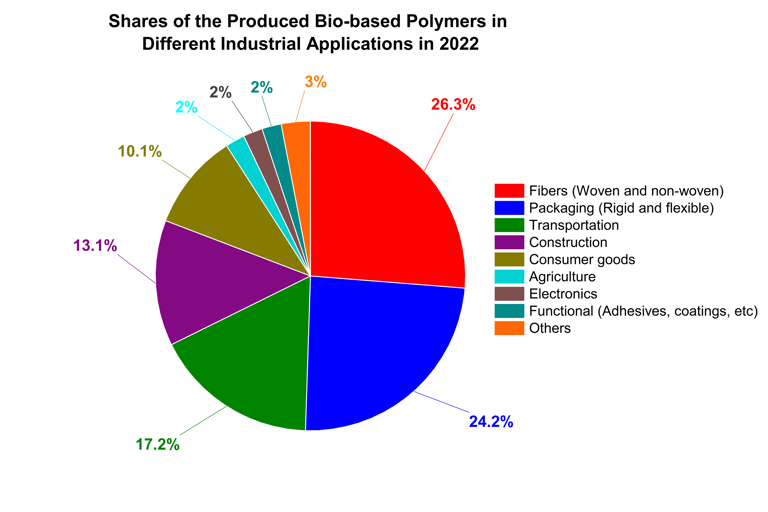

The increasing environmental concerns and the push towards circular economies have significantly driven the research and development of bio-based polymers. However, challenges such as cost competitiveness, scalability, and end-of-life management remain to be addressed. Overall, bio-based synthetic polymers represent a pivotal step towards sustainable material innovation, aligning with global efforts to mitigate climate change and promote environmental stewardship.
Let's look into some of the commonly used bio-based polymers:
1. Polylactic acid (PLA)
Polylactic Acid (PLA) is a renewable and biodegradable thermoplastic polymer derived from natural resources such as sugarcane, corn starch, or cassava. Known for its eco-friendliness, PLA has gained importance as a sustainable alternative to petroleum-based plastics. It exhibits high mechanical strength, good thermal properties, and biocompatibility, making it suitable for applications in packaging, 3D printing, medical implants, and textiles. PLA is biodegradable under industrial composting conditions, breaking down into non-toxic byproducts like water and carbon dioxide, which aligns with environmental sustainability goals.
The manufacturing process of PLA begins with the production of lactic acid through the fermentation of sugars obtained from biomass. This lactic acid is then polymerized using two primary methods: direct condensation polymerization and ring-opening polymerization (ROP). Direct condensation involves the removal of water to form PLA, but it yields low molecular weight polymers. The more efficient ROP method converts lactic acid into lactide, a cyclic dimer, which is then polymerized using catalysts to produce high molecular weight PLA with better properties. After polymerization, the PLA is purified, melted, and extruded into pellets, which can be processed further using techniques like injection molding, extrusion, blow molding, or 3D printing. The versatility and sustainability of PLA make it a preferred choice in various industries, contributing to the reduction of plastic waste and promoting a circular economy.
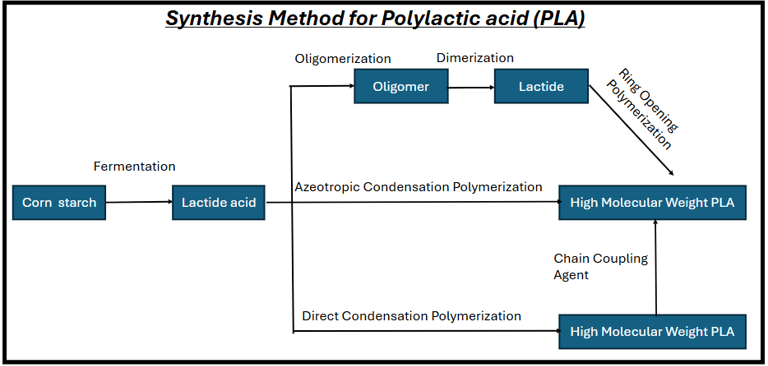

PLA has a reduced carbon footprint compared to traditional plastics and decomposes into non-toxic products like CO₂ and water in composting conditions. However, its industrial composting requirements and competition with food supply for raw materials pose challenges that are the focus of ongoing research.
Applications:
Automotive Industry: Utilized in making biodegradable and lightweight automotive components. Also, used for sound and thermal insulation in vehicles.
Packaging Industry: PLA is used for producing biodegradable cups, plates, utensils, and food containers.
Textile Industry: PLA is utilized to produce biodegradable fabrics for clothing, upholstery, and nonwoven textiles.
3D Printing: PLA is one of the most popular filaments for 3D printing because of its low melting point, ease of usage, and low environmental impact.
Biomedical: Biodegradable and biocompatible implants such as pins, screws, and plates. Also used for creating lightweight and durable prosthetic components.
Advantages:
Biodegradability: Breaks down in industrial composting conditions into non-toxic byproducts.
Safe for Contact with Food: Approved for use in food packaging because of it's non-toxic nature.
Low Carbon Footprint: Compared to polymers derived from petroleum, production of PLA results in lower greenhouse gas emissions.
Renewable Resource Base: Produced using plant-based feedstocks such as sugarcane or maize starch.
Simplicity of Processing: Suitable with a number of manufacturing processes, such as 3D printing, extrusion, and injection molding.
Disadvantages:
Mechanical Properties: Brittle and less resistant to impact than other polymers, such as PET or ABS.
Cost: Generally, the complexity of PLA production makes it more costly than traditional plastics.
Thermal Sensitivity: It's low glass transition temperature (around 60°C) restricts its use in applications requiring high temperatures.
Limited Moisture Resistance: Hydrolysis susceptibility may compromise durability in humid conditions.
Industrial Composting Requirement: Effective degradation necessitates particular circumstances, such as high humidity and warmth, which aren't usually present.
2. Polybutylene Succinate (PBS)
Polybutylene Succinate (PBS) is a biodegradable aliphatic polyester known for its eco-friendly properties and versatility. Derived from renewable or petroleum-based sources, PBS has gained prominence as a sustainable alternative to conventional plastics. It exhibits excellent thermal stability, flexibility, and mechanical properties, making it suitable for applications in packaging, agricultural films, disposable tableware, and biodegradable mulch films. Its biodegradability in industrial composting conditions further enhances its appeal in efforts to reduce plastic pollution and promote environmental sustainability.
The manufacturing process of PBS typically involves the polymerization of succinic acid and 1,4-butanediol, which can be derived from either fossil-based or bio-based sources. The process begins with the esterification of succinic acid with 1,4-butanediol, producing an intermediate oligomer. This oligomer undergoes polycondensation at high temperatures and reduced pressure, resulting in high molecular weight PBS. With advancements in biotechnology, bio-based production of succinic acid through microbial fermentation is becoming more common, enhancing the sustainability of PBS manufacturing. The polymer can then be processed into various forms, such as pellets, films, or fibers, using conventional techniques like extrusion, injection molding, or blow molding. PBS’s compatibility with renewable resources and its compostable nature position it as a promising material for addressing global environmental challenges.
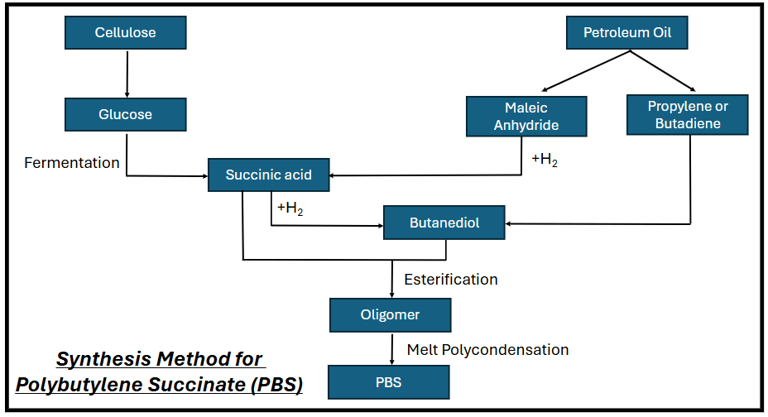

Applications:
Compostable Tableware and Utensils: PBS is frequently utilized in making biodegradable plates, bowls, straws, and cutlery.
Consumer Goods: Toothbrush handles, razors, and other personal care items. Also used in making toys and household items.
Automotive Industry: Lightweight and durable interior components such as trims and door panels.
Healthcare and Medical: Disposable medical products such as surgical masks, gloves, and packaging.
Advantages:
Biodegradability: PBS decomposes naturally in composting conditions, reducing plastic waste.
Hydrophobic nature: Provides water absorption resistance, which is advantageous for some agricultural and packaging applications.
Versatility: PBS can be blended with other polymers or reinforced with fibers to enhance specific properties.
Non-Toxic: Safe for utilization in medical and food-contact applications.
Disadvantages:
Higher Cost: PBS is more costlier than conventional non-biodegradable plastics like polypropylene and polyethylene.
Mechanical Properties: It's employment in high-performance applications may be limited due to its lower tensile strength when compared to certain traditional polymers.
Additive Requirements: Often needs to be blended with other polymers or given additives to enhance performance, which could jeopardize its complete biodegradability.
Slow Degradation in Natural Conditions: Need industrial composting facilities to decompose effectively. In natural environments, it might not decompose rapidly.
3. Polyhydroxyalkanoate (PHA)
Polyhydroxyalkanoates (PHA) are a class of biodegradable and biocompatible polymers synthesized by microorganisms as intracellular energy storage materials. Derived from renewable resources, PHAs are recognized for their excellent environmental compatibility and ability to degrade in a variety of natural environments, including soil, water, and industrial composting conditions. These polymers exhibit a wide range of mechanical properties, from rigid to elastomeric, depending on their monomer composition, making them suitable for applications in packaging, agriculture, biomedical devices, and textiles. The non-toxic and renewable nature of PHAs positions them as an eco-friendly alternative to traditional plastics.
The manufacturing process of PHA involves microbial fermentation, where specific strains of bacteria, such as Ralstonia eutropha or Cupriavidus necator, are cultured in nutrient-rich environments. The fermentation process typically uses carbon-rich feedstocks like sugars, plant oils, or industrial by-products. During nutrient limitation (e.g., nitrogen or phosphorus deficiency), bacteria produce PHAs as intracellular granules. These granules are then harvested by breaking open the cells through mechanical or chemical processes, followed by purification to isolate the polymer. The purified PHA can be processed into films, fibers, or molded products using conventional polymer processing methods. With advancements in biotechnology and the use of waste feedstocks, PHA production is becoming increasingly cost-effective and sustainable, contributing to its growing adoption as a solution to plastic waste and pollution.
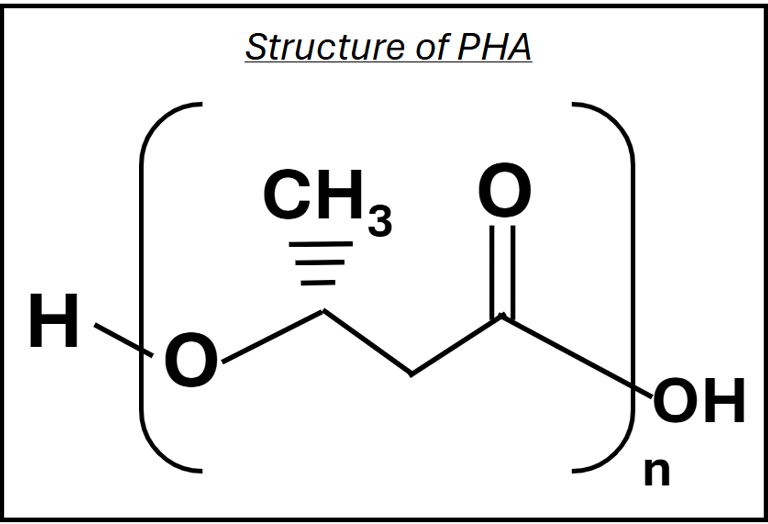

Applications:
Automotive Industry: PHAs are utilized for making lightweight components such as, interior panels, and trims.
Packaging Industry: Biodegradable films, containers, and bottles for food and non-food products.
Medical sector: Sutures, tissue engineering scaffolds, and drug delivery systems due to biocompatibility. Also used for making biodegradable implants and wound dressings.
Electronics sector: Biodegradable casings and parts for electronic devices.
Advantages:
Biocompatibility: They are non-toxic and compatible with living tissues, making them suitable for medical applications.
Diverse Material Properties: PHAs can be tailored to exhibit properties ranging from flexible to rigid, depending on the monomer composition.
Compostability: Unlike some bioplastics, PHAs can fully decompose in industrial composting facilities.
Thermal Stability: Some PHA types exhibit good thermal stability, allowing processing with conventional plastic manufacturing techniques like injection molding and extrusion.
Disadvantages:
High Production Cost: Compared to petroleum-based plastics, PHAs are more expensive to produce, limiting widespread adoption.
Dependency on Feedstock: The cost and sustainability of PHAs depend on the availability and price of raw materials like sugars or oils.
Mechanical Properties: PHAs may have lower impact strength and flexibility compared to some synthetic polymers, limiting certain applications.
4. Polyethylene Furanoate (PEF)
Polyethylene Furanoate (PEF) is an innovative bio-based polyester derived from renewable resources like plant sugars. It has gained attention as a sustainable alternative to petroleum-based Polyethylene Terephthalate (PET) due to its superior barrier properties for oxygen, carbon dioxide, and water vapor. These attributes make PEF particularly suitable for applications in packaging, especially for food and beverages. Additionally, PEF boasts a higher mechanical strength and thermal stability compared to PET, while its biodegradability under certain conditions enhances its environmental appeal. Its entirely bio-based origin aligns with the global push toward reducing dependence on fossil fuels and minimizing environmental impact.
The manufacturing process of PEF involves the polymerization of 2,5-furandicarboxylic acid (FDCA) and monoethylene glycol (MEG), both of which can be derived from biomass. FDCA is produced through the catalytic oxidation of 5-hydroxymethylfurfural (HMF), a compound obtained from the dehydration of sugars. MEG, another bio-based component, is derived from renewable resources like sugarcane or corn. These monomers undergo esterification to form an oligomer, followed by polycondensation under controlled conditions to yield high molecular weight PEF. After polymerization, PEF is processed into various forms such as films, fibers, or bottles using standard techniques like extrusion or injection molding. The combination of bio-based origins, enhanced material properties, and environmental benefits positions PEF as a promising material for the future of sustainable plastics.
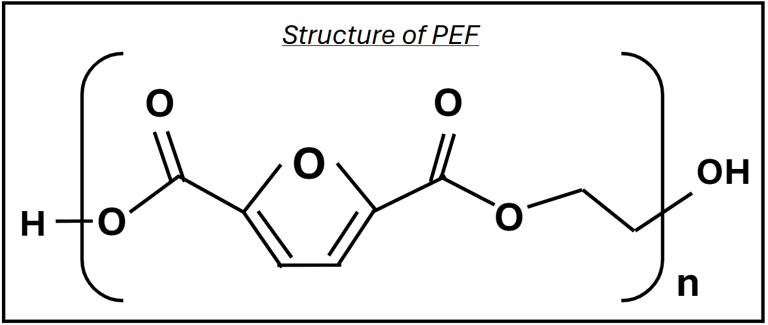

Applications:
Textiles: Fibers for clothing, carpets, and industrial fabrics.
Automotive Industry: Due to it's high strength and thermal stability, PEF is used for making lightweight interior components such as trims and upholstery fabrics.
Packaging Industry: Bottles for beverages (e.g., water, soda, beer) and food containers and films for perishable goods.
Advantages:
Superior Barrier Properties: Extends the shelf life of products by providing superior oxygen, carbon dioxide, and water vapor barrier performance when compared to PET.
Recyclability: Can be recycled similarly to PET, supporting circular economy efforts.
High Mechanical Strength: Provides excellent tensile strength, enabling thinner and lighter packaging without compromising durability.
Thermal Stability: Can withstand higher temperatures than PET, making it suitable for hot-fill applications.
Disadvantages:
High Production Costs: Manufacturing PEF is currently more costlier than PET due to limited scale and specialized processes.
Competing Materials: Faces competition from PET and other bio-based plastics like PLA, especially in cost-sensitive markets.
Limited Availability: Production is not yet widespread, restricting its accessibility for large-scale applications.
Processing Challenges: Requires optimized equipment and conditions, which may not be readily available in existing facilities.
5. Polytrimethylene Terephthalate (PTT)
Polytrimethylene Terephthalate (PTT) is a versatile thermoplastic polyester known for its excellent mechanical, thermal, and aesthetic properties. It is widely used in textiles, carpets, and engineering plastics due to its superior elastic recovery, softness, and durability. PTT also exhibits high stain resistance, dimensional stability, and good dyeability, making it an attractive choice for clothing and home furnishing applications. A significant sustainability advantage of PTT is its potential to be partially bio-based, as one of its monomers, 1,3-propanediol (PDO), can be produced from renewable resources like corn glucose. This feature positions PTT as an eco-friendly alternative to traditional petrochemical-based polymers.
The manufacturing process of PTT involves the polymerization of 1,3-propanediol (PDO) and terephthalic acid (TPA). PDO can be obtained through petrochemical methods or bio-based fermentation of sugars, while TPA is typically derived from petroleum feedstocks. The production process begins with the esterification of TPA and PDO, forming an intermediate oligomer. This oligomer is subjected to polycondensation at elevated temperatures and reduced pressure, resulting in high molecular weight PTT. The polymer is then cooled, pelletized, and processed into fibers, films, or molded parts using techniques like melt spinning, extrusion, or injection molding. The bio-based production of PDO and the recyclability of PTT enhance its sustainability profile, making it an increasingly popular material in environmentally conscious industries.
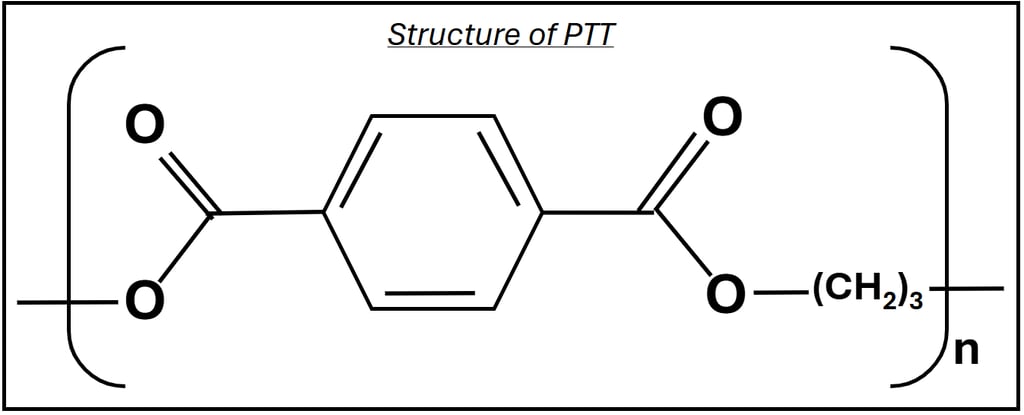

Applications:
Automotive Industry: Due to it's durability, PTT is used in making seat covers and floor mats.
Engineering Plastics: Injection-molded parts for electronics, appliances, and machinery.
Packaging Industry: Flexible and rigid packaging films for food and beverages.
Carpeting and Flooring: Utilized in residential and commercial carpets, rugs, and mats owing to it's resilience, and long-lasting color retention.
Advantages:
Eco-Friendliness: Reduced carbon footprint due to lower production energy requirements when compared to substitutes like PET and nylon.
High Resilience and Elasticity: PTT has excellent recovery and stretch properties, making it ideal for textiles and carpets.
Durability: PTT is known for high tensile strength, abrasion resistance, and dimensional stability.
Thermal Stability: PTT can withstand high temperatures without significant deformation.
Chemical Resistance: Resists degradation from many chemicals, enhancing longevity in various applications.
Disadvantages:
Costlier: More expensive to produce than some competing polymers like PET or polypropylene.
Limited Availability: Its adoption is limited because it is not as accessible or widely produced as other polymers.
Processing Hurdles: Requires specific tools and conditions for the best possible polymerization and utilization.
Hydrolysis Sensitivity: Can degrade under prolonged exposure to water and high temperatures.
6. Bio-Based Polyethylene (Bio-PE)
Bio-polyethylene (Bio-PE) is a renewable alternative to conventional polyethylene, one of the most widely used plastics globally. Unlike traditional polyethylene, which is derived from fossil fuels, Bio-PE is produced using ethanol obtained from renewable sources such as sugarcane, corn, or other biomass. It retains the same chemical structure, properties, and performance characteristics as fossil-based polyethylene, including durability, flexibility, and resistance to moisture and chemicals. This identical structure allows Bio-PE to be seamlessly integrated into existing recycling systems, making it an eco-friendly option for industries like packaging, automotive, and construction while reducing dependence on non-renewable resources.
The manufacturing process of Bio-PE begins with the production of ethanol through the fermentation of sugars from biomass feedstocks. This ethanol is then dehydrated to produce ethylene, the primary monomer for polyethylene. The ethylene undergoes polymerization, typically via processes like high-pressure polymerization or catalytic polymerization, to form polyethylene. The resulting Bio-PE can be classified as low-density polyethylene (LDPE), high-density polyethylene (HDPE), or linear low-density polyethylene (LLDPE), depending on the polymerization method and catalyst used. Since Bio-PE has the same molecular structure as conventional polyethylene, it offers identical performance while significantly reducing greenhouse gas emissions during its lifecycle, making it a key player in the transition toward sustainable plastics.


Applications:
Automotive Sector: Utilized in fuel tanks, interior trims, and under-hood components.
Agriculture Sector: Used in making irrigation pipes, mulch films, and seedling trays as it enhances sustainability in agricultural practices.
Packaging Industry: Bio-PE is used in creating Films, pouches, and wraps for food and non-food items.
Medical and Healthcare: Owing to it's safe and non-toxic nature, Bio-PE is employed for making disposable syringes, medical packaging, and lab equipment.
Advantages:
Recyclability: Bio-PE is chemically identical to conventional PE and can be recycled in the same streams.
Biocompatibility: Safe for utilization in medical and food packaging applications.
Carbon-Neutral Potential: Emissions from its production and consumption are countered by the plant-based feedstock's absorption of CO₂ during growth.
Renewable Feedstock: Produced from renewable sources like sugarcane or corn, reducing reliance on fossil fuels.
Disadvantages:
High cost: Due to raw materials and smaller production scales, production costs are currently higher than those of conventional PE.
Energy-Intensive Production: While bio-based, the production process still requires significant energy, which might partially offset environmental benefits.
Limited Availability: Not as widely produced or distributed as conventional polyethylene.
Resource Competition: Agricultural feedstocks may compete with food production, raising ethical concerns.
7. Bio-Based Polypropylene (Bio-PP)
Bio-based polypropylene (Bio-PP) is a sustainable alternative to conventional polypropylene, a widely used thermoplastic polymer in industries such as packaging, automotive, and consumer goods. Unlike traditional polypropylene, which is derived from petroleum-based feedstocks, Bio-PP is produced using renewable resources such as biomass-derived sugars or plant-based oils. It shares the same chemical structure and properties as fossil-based polypropylene, including high strength, chemical resistance, and versatility, ensuring its compatibility with existing manufacturing and recycling systems. The bio-based origin of Bio-PP significantly reduces its carbon footprint, contributing to global efforts for sustainable and environmentally friendly materials.
The manufacturing process of Bio-PP involves producing bio-based propylene, the monomer for polypropylene. This is typically achieved by fermenting biomass, such as sugarcane or corn, to produce ethanol, which is then dehydrated to form bio-ethylene. Through a catalytic process called metathesis, bio-ethylene is converted into bio-propylene. Alternatively, some processes utilize biomass-derived glycerol or other intermediates to produce bio-propylene. The bio-propylene undergoes polymerization, using techniques like Ziegler-Natta or metallocene catalysis, to produce Bio-PP with desired molecular properties. The resulting polymer can be processed using conventional methods like extrusion, injection molding, or blow molding. With its renewable origins and reduced environmental impact, Bio-PP is an emerging material that aligns with the goals of a circular economy and sustainable development.

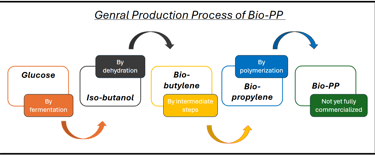
Applications:
Automotive Industry: Utilized in interior and exterior components such as dashboards, door panels, fenders, bumpers, and mirror housings.
Packaging Industry: Bio-PP is used in making containers for food and beverages. Furthermore, it is used in films and wraps for consumer goods.
Sports: Sporting equipment such as helmets, protective gear, and outdoor furniture owing to it's high strength-to-weight ratio.
Textiles: Due to it's lightweight and durable nature, it is utilized in making rugs, carpets, and nonwoven fabrics.
Advantages:
Recycling Compatibility: Can be recycled in the current recycling streams alongside regular PP.
Comparable Properties to Fossil-Based PP: Provides similar chemical, mechanical, and thermal properties, making it appropriate for use in current PP applications.
Reduced Carbon Footprint: Produces less greenhouse gas emissions during its lifecycle compared to petroleum-based PP.
Biodegradable Additives: Biodegradable additives can be used alongside Bio-PP to improve its environmental friendliness.
Disadvantages:
Cost: Higher manufacturing costs compared to conventional PP due to raw material and processing expenses.
Limited availability: Compared to fossil-based PP, Bio-PP is not yet as commonly produced or accessible.
Infrastructure Dependency: Relies on established biomass supply chains and specialized facilities for production, which may not be widely available.
Environmental Impact of Agriculture: Large-scale cultivation of bio-feedstocks can lead to deforestation, soil degradation, and increased use of water and fertilizers.
